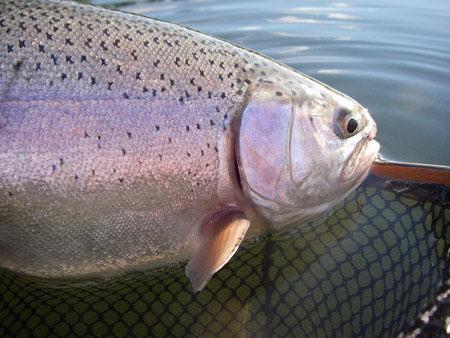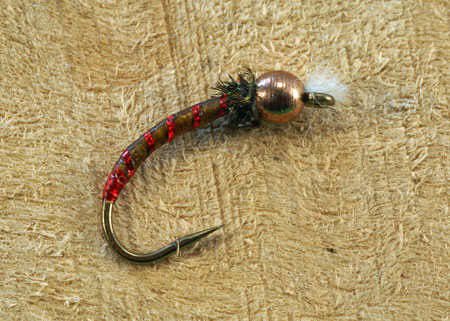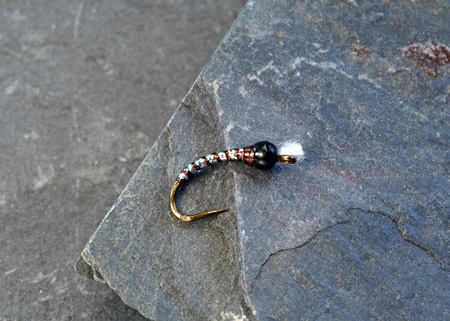 |
| Always have a selection of smaller patterns, especially chironomid pupa. | It was bound to happen sooner or later and it did, lack of attention to my fly box finally caught up with me earlier this spring. Late April, Corkies and a dense and varied armada of boats surrounded me as I sat in my pram on Sawmill Lake. Large trout were actually able to make it through the monofilament curtain and feed. Chironomids emerged in steady numbers so I felt confident in my ability to hook one of Sawmill's legendary fish. After all other anglers were into trout on a fairly consistent basis. I began with a size 12 Black Sally, a favorite design. After twenty minutes changes began, black and copper, bloodworm, Collaborator, and so on until I down sized to a number 14 Chromie. Finally I hooked a fish, the surface erupted as the five pound plus fish cart wheeled across the surface. But in the crowded conditions I had to bully the trout into staying close by. It didn't work, despite the side pressure I couldn't turn the fish and I ended up pulling the hook free. It was to be my last hook up of the day. My fishing partner Will managed to coax over half a dozen fish to his tiny size 16 lime green chironomid. I could only sit on the sidelines and watch in frustration my fly box was devoid of tiny patterns, larger flies of seasons past had spoiled me and attrition had taken its toll.
 In British Columbia we are somewhat spoiled by the relative size of some our insects as compared to other areas of North America. Take chironomids for instance, there are few places in North America that boast of inch long larva and pupa. Many of our insects are so big that we consider a size 12 hook small. I have a good friend who jokingly states, "If they are eating size 16's they won't be getting them from me!" Despite this luxury it is prudent for all fly fishers and fly tyers to remember the little guys. In the late fall most insect cycles are complete leaving only the smaller immature stages for trout to prey upon. Tiny mayfly and damsel nymphs are great patterns to use at this time of the season. Ask any Cariboo angler about the importance of micro leeches. On many of the provinces clear lakes such as White, Sheridan and Lac Des Roche small species of insects can predominate such as Caenis mayflies and of course chironomids. Keep in mind no mater what their size trout tend to eat small things, and lots of them. It is one of the traits that make trout such a worthy quarry for the fly rod. In British Columbia we are somewhat spoiled by the relative size of some our insects as compared to other areas of North America. Take chironomids for instance, there are few places in North America that boast of inch long larva and pupa. Many of our insects are so big that we consider a size 12 hook small. I have a good friend who jokingly states, "If they are eating size 16's they won't be getting them from me!" Despite this luxury it is prudent for all fly fishers and fly tyers to remember the little guys. In the late fall most insect cycles are complete leaving only the smaller immature stages for trout to prey upon. Tiny mayfly and damsel nymphs are great patterns to use at this time of the season. Ask any Cariboo angler about the importance of micro leeches. On many of the provinces clear lakes such as White, Sheridan and Lac Des Roche small species of insects can predominate such as Caenis mayflies and of course chironomids. Keep in mind no mater what their size trout tend to eat small things, and lots of them. It is one of the traits that make trout such a worthy quarry for the fly rod.
When it comes to sitting down at the vise to stock the low end of the size spectrum there are a number of issues to consider. The most obvious is the hook. Just about every frontline manufacturer offers a full range of hook sizes and styles far beyond what is needed here in British Columbia. For those who aren't thrilled about tying on size 16 or smaller hooks there are a couple of options. First of all the curved shank scud or sedge pupa hooks such as Mustad's C 49S or C 67S within their new Signature Series offer a wide gape and short shank enabling the use of a hook size larger than a standard shank hook. In other words a size 16 scud pupa hook is of the equivalent overall size to a standard size 18. This gives the fly tyer a larger tying platform and provides additional weight and hooking power. Some smaller hook styles in lighter wire can disfigure or straighten under the strain of a quality fish. Fly tyers can even tie their flies using a low water approach by tying a size 16 fly on a size 14 hook by simply not using the entire hook length. For reasons known only to the fish they can be picky about fly size and color but always seem to miss the business end of the hook. A fact we are all thankful for!
On stillwaters in particular presenting flies using a floating line in conjunction with a long fifteen foot or better leader is a popular and deadly tactic. Weighted flies are practically a must with this method, especially if the wind whips up. Wind causes circulation currents that can pull the fly out of the strike zone. Weighting a size 14 or smaller fly presents some unique challenges in order to keep the pattern balanced and proportional. Thanks to the widespread popularity of metal, lead and tungsten beads there are a wide range of sizes available to the tyer. For my tying purposes I use one-eighth beads for hook sizes 10 and bigger, three thirty-seconds for size 12 and 14 and size five sixty-fourths for size 16 and smaller. Fine copper, silver or gold wire is another option. Wire bodied patterns such as the Brassie have proven deadly over the years, especially as chironomid larva imitations. Under selective conditions trout can become wary to the flash of a wire body or bead head so the somber body of a fly must mask the weight. To do this take .010" diameter lead wire substitute and squash it flat with a pair of flat nose pliers. Secure the squashed lead along the shank prior to tying the fly to create a thin weighted underbody. Dental x-ray lead or lead from some wine bottles already comes flattened and presents another option. For those who prefer not to weight their patterns there is always the option of split shot or lead putty. Swapping the floating line for an intermediate or one of the new "midge tip" fly lines is another consideration. Often a change of retrieve angle provides the winning tactic.
 |
| Ken Woodward's Copper Chromie is an excellent pattern, both small and large. | When it comes to tying a small pattern errors in proportions are magnified. In some cases one or two thread wraps forwards or backwards can create a half shank error. In selective circumstances trout fussy enough to choose a tiny pattern can refuse an unbalanced offering. The good thing about smaller patterns is that they are best kept simple. Keep the four basic traits, size, shape, color and behavior as the guideposts. The first three are obvious behavior however is twofold. Behavior is a function of materials selection in regards to movement, translucency etc. and presentation or retrieve. Immature or baby damsel patterns for instance need only consist of a balanced mobile tail, slim body and perhaps a bead to provide addition attraction or action. Eyes, wingcases and legs just aren't necessary. Thread choice also has a bearing. For smaller patterns use thin diameter 8/0 or smaller tying thread. Gudebrod and other manufactures are also offering strong diameter 10/0 thread as well making it a perfect choice for smaller than average patterns.
To view the rest of this article, please login or join now for free!
|



